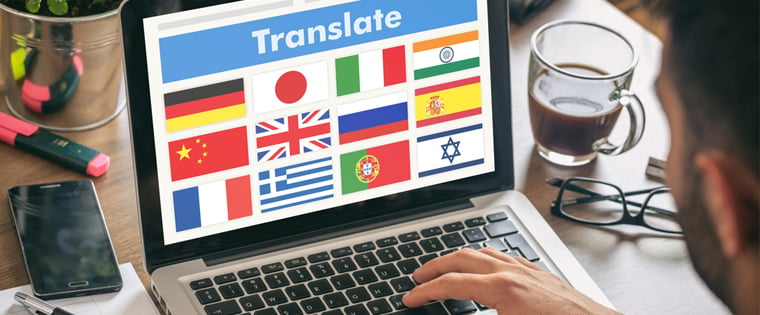The Top 4 Benefits and Best Practices of eLearning Localization in Corporate Training
With technology bringing the global population closer together, eLearning localization has become a critical requirement for training programs to stay relevant and effective. This article discusses the benefits and tips for localizing your training program.

Globalization is not without its drawbacks. Sensibilities and trigger points change amidst cultures and languages. This makes it tough to create an eLearning course that is relevant and valuable to everyone throughout your company’s vast geography. What are our options for overcoming this obstacle? It is simply not enough to translate eLearning courses into employees’ local languages. eLearning localization helps you guarantee that an online course is culturally acceptable amongst different learner ethnicities.
When learning is culturally relevant and interesting, it becomes powerful. Also, online training that is offered in the learner’s local language is more effective. Translation and localization of eLearning material improves training consistency for internationally dispersed learners. It successfully communicates the company’s rules and processes to employees while presenting a consistent message throughout.
What are the best practices for eLearning Localization?
The Top 4 Secrets of Successful eLearning Localization:
1. Recognize your Target Audience and Their Culture
2. Identify the Need for Localization in the Early Stages of eLearning Development
3. Consider White Space Constraint
4. Ensure Proper Coordination with All Stakeholders
What is eLearning Localization?
eLearning localization conforms an eLearning course’s content to a specific place and its culture. Even though we frequently use both phrases eLearning translations and localizations interchangeably, they mean two very different things.
Only part of the meaning of the word “translation” is shared with the word “localization.” Localization requires adapting an eLearning course to a target culture, as opposed to merely translating it from one language to another. You need to modify:
- Symbols, images, and photographs
- Graphic User Interface (GUI)
- The audio narration’s tone
- Measurement systems, dates, and currencies
- Typefaces
- Abbreviations and idioms
in your eLearning courses. The fact that eLearning overcomes obstacles like location and expense is what drives its prominence in the post-pandemic society. There are a variety of factors that may influence your decision to localize your eLearning courses, such as the cost of localization as well as a health and safety considerations.
eLearning localization has several advantages for your organization, and it produces excellent outcomes all around the world. Do you want to translate and adapt your eLearning courses to fit the demands of your employees working in other countries? In this article, we’ll look at the top 4 advantages of localization for learners. We’ll also explore sure-shot recommendations to make sure your technology-enabled localization initiative is a tremendous success.
eLearning Translations – 7 FAQs Answered
The Top 4 Benefits of eLearning Localization in Corporate Training
1. Eliminates Cultural Disparities
eLearning localization effectively handles cultural differences in different geographies. Green is the national color of Mexico, and it symbolizes independence; however, in Indonesia it’s a forbidden color. Red relates to holiness and spirituality in India, but in Africa it symbolizes death. Yellow has a negative connotation in Germany, but in Egypt it’s a positive color. This shows how each nation and region has its own unique culture. Do you think African nations would accept an eLearning course with predominantly red backgrounds and visuals? No way!
Apart from the colors, gestures, and symbols of your courses, the tone of the audio narration is very important as in the west they prefer an open, pleasant tone. Whereas nations in the East prefer authoritative tones. If you consider cultural differences, then you can avoid misinterpretations and make your eLearning material more relevant to the learner. It also helps you attract learners from all around the world as your courses are available in their native tongue.
It’s as straightforward as this: 400 million people around the world speak Spanish; Chinese is spoken by over 1 billion people; over 250 million people speak Arabic; and millions of people speak Hindi, Russian, German, Japanese, and French. You essentially double and triple the number of learners by undertaking eLearning localization.
2. Enriches the Acquisition and Retention of Knowledge
When you localize your course, it becomes more effective because employees can relate to the information on a cultural level. A poorly translated phrase, for example, can dilute your message, but well-translated idioms will improve the learners’ understanding. Learners retain knowledge more effectively, allowing them to perform more efficiently on the job.
What happens if you don’t localize? In such cases, there would be a lack of connection with the course, and employees become distracted and lose interest. Many workers do not use English as their first language, this leads to cultural and business misconceptions. However, with eLearning content localized and tailored to staff from diverse backgrounds, a firm can readily go forward, as now all their employees, regardless of location, are enabled to learn with efficiency.
3. Employee Retention and Satisfaction
Taking action and localizing training content improves credibility and authority in any sector. Localization shows your organization the importance of eLearning translation. By focusing on supporting as many languages as possible, your firm propels itself as a truly global organization that values its learners. For businesses looking to gain a competitive edge, providing culturally sensitive corporate training programs is essential.
When a company customizes courses to their employees, they indicate how valuable their employees are no matter where they work or what language they speak. Employees are loyal because of their increased satisfaction at work. Employees learn more effectively and easily if organizations provide courses in their native language as well as covers topics in a manner that are familiar to them. As a result, their confidence grows, and their performance improves.
4. Encourages a Culture of Inclusive Learning
Organizations that adapt courses to their learners needs instead of churning them out to the masses without regard for language or culture also produce immense value-add. When your organization uses one module to train employees in multiple locations, they ensure training consistency. Your company can ensure its employees in different countries have the same skill sets and knowledge by making the same textual and multimedia content available to all participants in their unique languages and contexts.
Localized eLearning courses are more likely to attract learners who are go-getters and look out for what they need when they need it. Localizing eLearning also provides a sense of organizational belonging and value, regardless of where your employees live.
Now that you know how localization can benefit corporate training programs, let’s look at the top 4 sure-fire tips to make sure your technology-enabled localization campaign is a massive hit.
4 Best Practices of eLearning Localization
1. Recognize Your Target Audience and Their Culture
Localizing training content, whether eLearning or otherwise, is impossible if you don’t have enough information about the audience you’re targeting. First, make certain that you learn more about your target audience. Then, based on language, country, and cultural preferences, divide your target audience into separate categories. This is critical because your online course may require many localized versions.
Citizens of Canada speak two languages, each with its own specific culture. This is a good example of how you can categorize your learners. You provide them their choice of language rather than them choosing where to live.
The last thing you want is your employees dismissing and not engaging with your eLearning courses. However, if you intend on localizing an eLearning course without first discovering background information on the target audience—then they quickly become disinterested. In fact, this is the first step to take when it comes to localizing an eLearning course.
2. Identify the Need for Localization in the Early Stages of eLearning Development
It’s critical to recognize the need for localization early in the eLearning design and development process. This will assist you in developing training in a way that is culture friendly. Here are some pointers to create a culture-friendly eLearning course:
- Use limited multimedia and basic colors and visuals to avoid wasting time and money on changing your multimedia.
- Wherever you can, try to use neutral imagery. Take, for example, Ronald McDonald’s image. Everyone connects with Ronald McDonald, no matter where they are from.
- Unless necessary, don’t use text on photos because retrieving it is an extra effort that adds to the time and cost of your project.
- To avoid further difficulty, make sure the typeface you choose is compatible with the target audience’s languages. These languages may not have your choice of font.
- Resist using idioms and humor as localizing them might be difficult.
3. Consider White Space
Translated information can increase or decrease depending on the target audience’s language. In Spanish, for example, the translated term for “welcome” is “Calida Bienvenida,” which is relatively long. Therefore, make sure there’s enough white space in the layout to accommodate the expanded text. You can reduce the expense and work of your eLearning translation if the space is planned. Localized text is often longer than when it’s in English. The German script, for example, takes longer to translate than the English language. There can be instances where the text box can’t contain the text.
When creating English-language online courses, make certain there is sufficient white space to facilitate text expansion. Ensure that the navigation bars, menus, and text boxes are flexible to avoid any such issues. This is critical to prevent additional work and it keeps eLearning expenses down.
4. Ensure Proper Coordination With All Stakeholders
Assign a single point of contact for each course that needs translation and localization. That individual must be held accountable for addressing content issues and conducting reviews for that specific localization. This simple method might help you sort through the chaos and add value to your eLearning translation.
This way, you can avoid delays and reduce costs of your eLearning localization. You also need to make certain that all your stakeholders are in the loop. If you choose a qualified individual as the Single Point of Contact (SPOC), then you can promote effective coordination and communication throughout the localization project.
Parting Thoughts!
When it comes to eLearning, it’s best to keep your global learners in mind. It’s also vital to maintain a broad perspective and allow for smooth translation processes. Effective localization of your online learning content contributes significantly to providing quality training to your global workforce.
While this blog focused on gaining insights into eLearning localization, are you aware of any existing or emerging eLearning trends that will keep on growing? Check out our eBook on “eLearning Trends 2022” to explore more about the increasing influence of eLearning. If you’re a training manager or a member of the L&D community, then don’t miss out on finding out what’s hot in corporate training!





